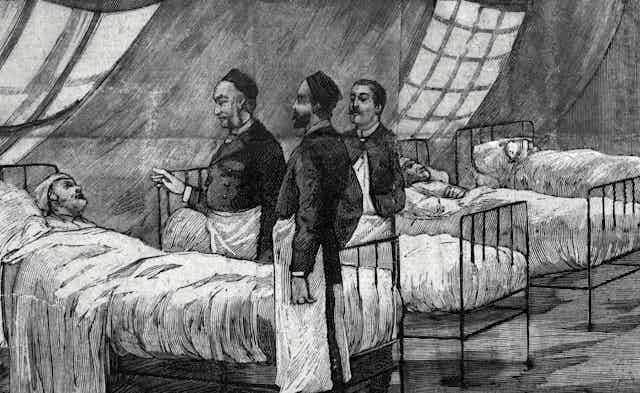COVID-19 was the first coronavirus pandemic. The original Sars virus from 2003 and the Mers virus that created a health emergency in South Korea in 2015 were both coronaviruses, but fortunately failed to turn into pandemics in the way that COVID did.
Four years on from its appearance, Sars-CoV-2 (the virus that causes COVID) now seems to be making the transition to an endemic virus: one that circulates in humans all the time, at least somewhere in the world. As is common in respiratory viruses, it also seems to be developing a seasonal preference for the colder, wetter times of the year.
But Sars-CoV-2 isn’t alone. There are four other circulating coronaviruses, named OC43, NL63, HKU-1 and 229E. The consensus is that these viruses are also descendants of past pandemics and that Sars-CoV-2 is just the latest member of their club.
This theory is based on the model provided by influenza viruses, where the familiar seasonal flus H3N2 and H1N1 are the descendants of the flu pandemics of 1968 and 2009, respectively.
Pinning a date on the last coronavirus pandemic
But when could these supposed four previous coronavirus pandemics have occurred?
The 19th century had three flu pandemics and so did the 20th century. We can read about these in the medical journals and newspapers of the time. However, we cannot do the same for coronavirus pandemics as the very idea of such a thing only reared its head with Sars-CoV-1 in 2003 (which caused severe acute respiratory syndrome or Sars).
Surely a past pandemic of COVID-like coronavirus pneumonia would have made the news? Or are we missing something?
Scientific interest in this topic has focused on one particular member of the endemic coronavirus quartet: OC43. Genome sequencing tells us it is closely related to bovine coronavirus.

Indeed, in 2005, the date for its zoonotic transmission – meaning the jump from cattle to humans – was roughly calculated as sometime between 1870 and 1890.
The historical veterinary record confirms there was an unexplained disease circulating globally in cattle at that time. Could it have jumped to humans, kicking off an OC43 pandemic?
Suspiciously, the pandemic of “Russian influenza” began in 1889 and ran well into 1893. Was that pandemic, always supposed to be influenza, really the last coronavirus pandemic prior to COVID?
The idea has caught on, even receiving a mention in the UK COVID public enquiry.
Or was it flu after all?
Flu virologists are unconvinced. Although the oldest flu genome sequences are those recovered from the frozen bodies of Alaskan victims of the devastating 1918-20 influenza pandemic, there is another way to investigate the ancient history of flu: seroarchaeology.
This method takes old blood samples out of the freezer and mixes them with flu viruses. An immunological reaction indicates that the blood sample contains antibodies to the specific types of flu viruses in the experiment. This implies that the person from whom the sample was taken successfully fended off such a flu virus at some time in their lives.
Seroarchaeology on archived blood samples shows that well before the H3N2 flu pandemic of 1968, there were elderly people in the population who mysteriously already had antibodies to similar types of flu viruses. And back in 1968, it had already been observed that older people had better survival rates than young ones, contrary to the usual pattern in influenza outbreaks.
Those octogenarians of 1968 had all been around in 1889-1893. The combination of that clinical observation and further seroarchaeology pinned down the pandemic of 1889-1893 to an influenza of type H3N8.
But if not 1889, then when?
The OC43 pandemic theory thus disappeared off the scientific radar. But it left a question: if the 1889-1893 pandemic was influenza H3N8, then when did OC43 make its zoonotic leap from cattle to humans?
A study from 2023 examined all the OC43 virus genome information that has accumulated since the original study. The date of the zoonotic transfer from cattle to humans was recalculated, using the latest generation of virus genome analysis software, at 1899-1900.
Examination of the total excess deaths per million of population in England and Wales over 1899 and 1900 gave a figure of 1,576 deaths per million, less than the 2,275 deaths per million for the Russian influenza, but only just short of the 1,866 deaths per million for the two worst COVID years of 2020 and 2021.
So why was this OC43 pandemic not spotted before? The answer is that the pneumonia epidemic of 1899-1900 had always been dismissed as a late wave of the 1889-1893 influenza. The missing coronavirus pandemic had been hiding in plain sight.

